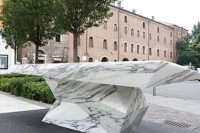

spirits of the Inca royalty guarded this
sacred city.
In July 1911, Hiram Bigham, Yale historian and explorer, led an expedition into these remote mountains to search for Vilcabamba, the last refuge of the Inca empire after the Spanish invasion. What he found was Machu Picchu, and his discovery of this previously unknown royal enclave tweaked the imaginations of armchair travelers around the world.
Machu Picchu, located about 75 miles northwest of Cuzco in southern Peru, sits on a ridge between two mountains - Huayna Picchu (young mountain) and Machu Picchu (old mountain) - overlooking the Urubamba River that winds far below on its way to the Amazon. At an altitude of 8,000 feet, the mountains are often shrouded in misty clouds that swirl around the peaks and the walls of the city, creating a aura of mysterious and ghostly apparitions keeping watch.
The Inca were the ruling nobility and their empire covered the highlands of the Andes Mountains from what is now Ecuador to present-day Chile - a span of over 3,000 miles. Machu Picchu was probably built by the Inca emperor Pachacuti in the mid-15th century and had a permanent population of about 1,500 people. It was built, occupied and abandoned over a 100-year period and the reasons for it being deserted remain a mystery. The Inca Empire ended in 1532, when Francisco Pizarro and his Conquistadors invaded and conquered the land. Machu Picchu was the only city to be spared the destruction of Inca religious sites, simply because the Spanish did not know it existed.

Creating Machu Picchu
The builders of Machu Picchu were skilled architects, engineers and master stonemasons who worked with the topography of the site, creating a harmonious balance between natural and man-made features. The city was carefully placed among sacred mountain peaks to serve as a prime observation spot for movements of the sun, and natural and constructed points throughout the city were used for making astronomical and solar observations. The building style is classic Inca, and the city includes a high proportion of religious architecture, giving rise to the theory that Machu Picchu served the high-ranking Inca nobility as the sacred center of their empire.Built entirely of granite quarried from the foothills of the Andes Mountains, the stonework of Machu Picchu is remarkable in its precision and style. Granite blocks were carved with edges that lock together without the use of mortar to form walls and buildings. This technique increased the stability of the structures that was necessary to survive the frequent earthquakes.
My pilgrimage to this once-abandoned city was to experience the power forces said to radiate from the earth on which the city was built. The Inca worshipped the Sun and the Moon and felt a strong kinship with the mountains, springs, caves and other natural wonders around them and thought of Mother Earth as alive with supernatural powers. They believed that man was created from the clay of the earth and that Machu Picchu was a sacred spot where life began by emerging out of the ground.

Reaching the city
Power forces were one attraction, but there was also my fascination with the down-to-earth construction of a graceful city built of granite by a people who did not know the wheel and did not have a written language. I wanted to climb the steps, explore the temples and run my hands over walls of granite blocks expertly carved without the use of iron tools.But first I had to get there. I flew from Lima, Peru's capital city, to Cuzco and planned to stay for a couple of days to acclimate to the 11,000-foot altitude. When I got off the plane and began walking, I felt as if I were pushing my way through a great bowl of jello. My body had difficulty moving through the thin air at that altitude.
The train left Cuzco early in the morning filled with day trippers who would return in the afternoon. Over the four-hour journey we passed through deep green jungle and small villages - where locals tried to sell everything from Coca-Cola to hand-woven blankets - and zig-zagged up and down mountains and through vast cattle ranches and farms. We arrived at the Puente Ruinas station in the Urubamba river valley mid-morning and queued up to get our tickets and ride the tram up and up the 12 kilometers of switchbacks to the entrance. Once on the mountain, I checked in to the Hotel Machu Picchu Ruinas, for my plan was to stay overnight and experience the city empty of day trippers.

A harmony of stonework
The first breath-taking glimpse of this mysterious city is from the agricultural sector where row upon row of terraces, constructed from granite blocks, follow the steep slopes of the mountain in perfect harmony down toward the valley. They served as retaining walls to prevent erosion and allowed gardens to grow the crops needed to feed the inhabitants of the city. With the lush deep greens of jungle-covered mountain peaks as the background, the city's walls and plazas spread out before me like a shimmering mosaic in the morning sunlight.I made my way past the fountains - a series of what were once small waterfalls probably used in Inca rituals for worshiping water - to the Temple of the Sun. This round tapering tower of elegantly crafted stone work contains sacred niches that once held idols or offerings to the gods. The centerpiece of the temple is a great rock, part of the actual outcrop on which the temple is built. Archaeo-astronomical studies have shown that the temple was an astronomical observatory. One of the trapezoid-shaped windows - and the altar stone that has a straight edge cut into it - align within two arc-minutes of the compass to the June solstice sunrise. This is as precise a measurement as you can get with the naked eye.
The urban sector of Machu Picchu was the most cosmopolitan of the areas and consists of nearly 200 enclosures of different shapes and sizes built of the same granite blocks and interconnected by stairways, alleys and narrow streets. Some of these buildings were used for housing the more important inhabitants of the city, some for religious and ceremonial purposes and others for storing food and supplies. Opposite the Sun Temple and across a wide staircase are a series of roomy structures that housed the Inca royalty. These buildings are characterized by huge granite lintels (some weighing up to three tons) used in the architecture of the homes of the highest of the mighty Inca.
Probably the most important of the shrines at Machu Picchu is the Intihuatana - the Hitching Post of the Sun. During the feast of Inti-raymi, celebrated on the shortest day of the year, Inca priests attempted to tether the Sun god to the hitching post to ensure his return the next summer. A total of 78 steps lead up to an open patio surrounded by well-crafted stone walls. In the center is a granite rock sculpted into three steps, its four corners directed to the four cardinal points, with a rectangular prism pointing from North-West to South-East. It was used to measure time - the solstice and the equinox - by using sunlight and shadow to calculate calendar dates and record lunar movements.
By the time I had explored the other temples and clambered about the terraces looking for the perfect photographic vantage point, it was late afternoon and the day trippers had disappeared. I found myself alone near the Fountain Caretaker's House, one of the few restored structures with a thatched roof, when it started to rain. I scrambled for shelter and watched the rain and clouds envelop the ruins of this magical place, savoring the deep quiet and listening for the spirits of the Inca priests. I ventured out across the misty plaza with well-placed steps on the slippery stones through a narrow alleyway to the edge of a terrace. There, beginning high in the sky and arcing deep into the valley below, was the most exquisite rainbow I had ever seen. The spirits had spoken.




